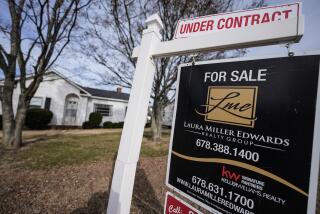Home Buyers Forced to Play ‘The Price Range Is Right’
When they decided early this year to go shopping for a house in the San Fernando Valley, Todd and Laura Davis braced themselves for sticker shock, bidding wars, disappointment and despair.
They didn’t reckon on one added strain: mystery pricing. None of the homes they liked came with a fixed price tag.
“All of them had this weird price range listed, and it wasn’t just a spread of a few thousand dollars,” said Todd Davis, a telecommunications manager who has since given up on Southern California and transferred to Washington. “It was like a $30-, $40-, sometimes $50,000 difference. And we’re looking at it going, ‘What does this mean? Where do we start?’
“I felt like we were on some game show or something.”
Welcome to the world of value-range pricing -- which, for better or worse, has become a fixture in Southern California’s overheated real estate market. Homes are advertised in a range: There are two prices, low and high, and buyers are asked to offer something in between.
Sellers like it because posting a gamut of prices can attract more bids than a single price might. Some real estate agents have made range pricing their calling cards. Others flat out refuse to show any property that doesn’t come with a solo asking price, because they think buyers can be duped by a range.
“It’s a sneaky way to get people to come see a property by making it look like it’s a great deal, when really it’s way over their heads and probably a jumbo waste of time,” said Steven Walker, a Coldwell Banker agent who operates in Studio City. “It’s misleading and frustrating and confusing all at once.”
A group of agents in the San Fernando Valley is so unhappy with range pricing that it is petitioning that area’s multiple-listing service for rules, such as requiring agents to clearly flag value-range properties and list the top price instead of the low in the system so that searches are more clear-cut.
But as long as too much demand continues to chase too little supply, the practice of giving buyers a price span -- one as wide as $370,000 on a million-dollar-plus home -- seems likely here to stay.
Agents say it comes into use whenever the real estate market heats up to boiling, but that it has never before been so popular in Southern California.
“The concept is really catching on because it’s very difficult to pinpoint the value of a property in today’s marketplace,” said Alice McCain, a real estate broker with Prudential California Realty in Northridge. “The definition of value is what a buyer is willing to pay and what a seller is willing to take. How can we determine what that is if we don’t offer some parameters to get the process going?”
There are buyers who are converts.
Jim and Sandra Gibson were mystified by the process when they made an offer last month on a Carlsbad, Calif., house priced from $365,000 to $425,876. But after some guidance from their agent-broker, and going through two rounds of counter-offers, the Gibsons closed the deal for $389,500.
“We never would have looked at homes priced at $425,000,” Sandra Gibson said. “This allowed us to consider properties in a whole new way.”
More than 31% of the active listings in San Diego County are range-priced, up from 25% last year, according to the county’s multiple-listing service. In Los Angeles and Orange counties, agents estimate the numbers to be 5% and 10%, respectively, with both having doubled during the last two years.
For sellers, listing a home within a range can garner more exposure and eliminate the need to consider low-ball bids. For buyers, having to guess at the right price in a range can be the last straw in an extremely difficult process.
“We finally gave up,” Todd Davis said of a monthlong house hunt, during which he and his wife made two offers on range-priced homes. “I just wanted someone to tell us flat-out what the price was.”
Like many agents, McCain uses range pricing on only certain properties -- those that have been more expensively remodeled than others in a neighborhood, or when a seller doesn’t like the price dictated by recent sales of comparable houses in an area. Other agents use it on only high-end properties, which tend to be more difficult to price.
Some, however, have begun range pricing every listing. Mike Monteleone, a Remax agent in Sherman Oaks, said he has sold 25 homes this year through range pricing, and they all commanded a price within 90% of the top end of the spectrum. With the 11 properties he currently has listed in a range, Monteleone said he probably will get 5% to 12% more for the sellers than if they had gone with a fixed asking price.
“I use it a lot because it gives my listings more exposure, which makes them sell faster, which makes everyone happy,” Monteleone said. “Some agents don’t like it, but I think they simply don’t understand it. It’s a lot more work and requires a lot more negotiating, but it gets results.”
Critics say a chief problem is that most multiple-listing service computer systems -- which agents and buyers use to find out what’s on the market -- can’t accommodate more than one price.
Only San Diego and Orange counties’ systems have been adjusted to support two figures, though some agents say that complicates searches.
In other counties, a search for a property listed at $350,000 to $450,000 could produce homes with top-end prices of more than $500,000 because of overlapping price ranges used by the systems.
“It’s sort of a goofy deal,” said Peter Hernandez, president of real estate brokerage Coldwell Banker in Orange County. “Naturally, a buyer is going to assume the lower price is the real price, when the seller thinks just the opposite. It’s a bit confusing, and that’s why we really don’t use it.”
But Carlton Lund, who specializes in range pricing for Prudential California Realty in northern San Diego County, said the technique is catching on fast, with agents snatching up seats at conferences and workshops that focus on the strategy. In San Diego County, 12,000 homes sold through range pricing last year, compared with 7,000 in 2001.
“I’ve sold more than $230 million in properties by using value-range pricing, and I’ve never had a listing expire,” Lund said. “I can’t imagine using anything else in this market, because no one really knows the true value of anything anymore.”
Howard M. Katchen, a Coldwell Banker real estate agent in Studio City, said he tried for five months to get the listing of a four-bedroom, four-bath home on Laurie Drive, pushing the owners to consider value-range pricing.
After interviewing two other agents who did not approve of the idea, owners Kelly and Dan Zuckerman eventually signed with Katchen, listing their single-story home with a view for $1.245 million to $1.389 million. The couple liked the idea of avoiding outrageously low offers while still introducing a lower asking price to attract more buyers.
“At first we thought, ‘Why would we do that?’ ” said Kelly Zuckerman, a marketing representative at Universal Studios. “But then it just started making sense. We have a better chance at creating a bidding frenzy because the number of potential buyers goes up quite a bit this way.”
Still, some buyers are daunted. Last weekend, Larry Pelle drove by a handful of homes that his agent had told him about in Winnetka and Canoga Park. He grabbed fliers from the front yards of two of the houses only to find they had price ranges -- a detail that didn’t show up in the multiple-listing service search.
Pelle, a civil engineer, promptly scratched them from his list.
“We’re looking for homes that are less than $525,000,” he said, already looking up the next address in his map book. “These actually start at $525,000 but you know they’re not going to settle for that. Not when their top price is $589,000. These will never work.”
More to Read
Inside the business of entertainment
The Wide Shot brings you news, analysis and insights on everything from streaming wars to production — and what it all means for the future.
You may occasionally receive promotional content from the Los Angeles Times.










